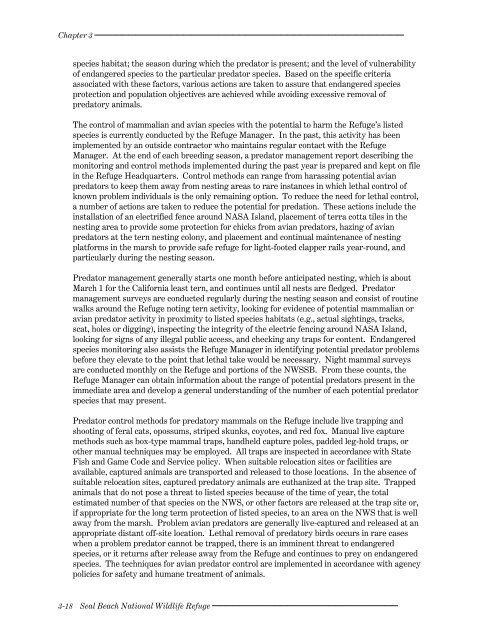Chapters 1 - U.S. Fish and Wildlife Service
Chapters 1 - U.S. Fish and Wildlife Service
Chapters 1 - U.S. Fish and Wildlife Service
Create successful ePaper yourself
Turn your PDF publications into a flip-book with our unique Google optimized e-Paper software.
Chapter 3 <br />
species habitat; the season during which the predator is present; <strong>and</strong> the level of vulnerability<br />
of endangered species to the particular predator species. Based on the specific criteria<br />
associated with these factors, various actions are taken to assure that endangered species<br />
protection <strong>and</strong> population objectives are achieved while avoiding excessive removal of<br />
predatory animals.<br />
The control of mammalian <strong>and</strong> avian species with the potential to harm the Refuge’s listed<br />
species is currently conducted by the Refuge Manager. In the past, this activity has been<br />
implemented by an outside contractor who maintains regular contact with the Refuge<br />
Manager. At the end of each breeding season, a predator management report describing the<br />
monitoring <strong>and</strong> control methods implemented during the past year is prepared <strong>and</strong> kept on file<br />
in the Refuge Headquarters. Control methods can range from harassing potential avian<br />
predators to keep them away from nesting areas to rare instances in which lethal control of<br />
known problem individuals is the only remaining option. To reduce the need for lethal control,<br />
a number of actions are taken to reduce the potential for predation. These actions include the<br />
installation of an electrified fence around NASA Isl<strong>and</strong>, placement of terra cotta tiles in the<br />
nesting area to provide some protection for chicks from avian predators, hazing of avian<br />
predators at the tern nesting colony, <strong>and</strong> placement <strong>and</strong> continual maintenance of nesting<br />
platforms in the marsh to provide safe refuge for light-footed clapper rails year-round, <strong>and</strong><br />
particularly during the nesting season.<br />
Predator management generally starts one month before anticipated nesting, which is about<br />
March 1 for the California least tern, <strong>and</strong> continues until all nests are fledged. Predator<br />
management surveys are conducted regularly during the nesting season <strong>and</strong> consist of routine<br />
walks around the Refuge noting tern activity, looking for evidence of potential mammalian or<br />
avian predator activity in proximity to listed species habitats (e.g., actual sightings, tracks,<br />
scat, holes or digging), inspecting the integrity of the electric fencing around NASA Isl<strong>and</strong>,<br />
looking for signs of any illegal public access, <strong>and</strong> checking any traps for content. Endangered<br />
species monitoring also assists the Refuge Manager in identifying potential predator problems<br />
before they elevate to the point that lethal take would be necessary. Night mammal surveys<br />
are conducted monthly on the Refuge <strong>and</strong> portions of the NWSSB. From these counts, the<br />
Refuge Manager can obtain information about the range of potential predators present in the<br />
immediate area <strong>and</strong> develop a general underst<strong>and</strong>ing of the number of each potential predator<br />
species that may present.<br />
Predator control methods for predatory mammals on the Refuge include live trapping <strong>and</strong><br />
shooting of feral cats, opossums, striped skunks, coyotes, <strong>and</strong> red fox. Manual live capture<br />
methods such as box-type mammal traps, h<strong>and</strong>held capture poles, padded leg-hold traps, or<br />
other manual techniques may be employed. All traps are inspected in accordance with State<br />
<strong>Fish</strong> <strong>and</strong> Game Code <strong>and</strong> <strong>Service</strong> policy. When suitable relocation sites or facilities are<br />
available, captured animals are transported <strong>and</strong> released to those locations. In the absence of<br />
suitable relocation sites, captured predatory animals are euthanized at the trap site. Trapped<br />
animals that do not pose a threat to listed species because of the time of year, the total<br />
estimated number of that species on the NWS, or other factors are released at the trap site or,<br />
if appropriate for the long term protection of listed species, to an area on the NWS that is well<br />
away from the marsh. Problem avian predators are generally live-captured <strong>and</strong> released at an<br />
appropriate distant off-site location. Lethal removal of predatory birds occurs in rare cases<br />
when a problem predator cannot be trapped, there is an imminent threat to endangered<br />
species, or it returns after release away from the Refuge <strong>and</strong> continues to prey on endangered<br />
species. The techniques for avian predator control are implemented in accordance with agency<br />
policies for safety <strong>and</strong> humane treatment of animals.<br />
3-18 Seal Beach National <strong>Wildlife</strong> Refuge

















